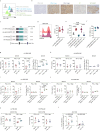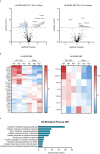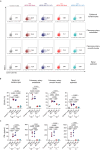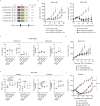CAR affinity modulates the sensitivity of CAR-T cells to PD-1/PD-L1-mediated inhibition
- PMID: 38670972
- PMCID: PMC11053011
- DOI: 10.1038/s41467-024-47799-z
CAR affinity modulates the sensitivity of CAR-T cells to PD-1/PD-L1-mediated inhibition
Abstract
Chimeric antigen receptor (CAR)-T cell therapy for solid tumors faces significant hurdles, including T-cell inhibition mediated by the PD-1/PD-L1 axis. The effects of disrupting this pathway on T-cells are being actively explored and controversial outcomes have been reported. Here, we hypothesize that CAR-antigen affinity may be a key factor modulating T-cell susceptibility towards the PD-1/PD-L1 axis. We systematically interrogate CAR-T cells targeting HER2 with either low (LA) or high affinity (HA) in various preclinical models. Our results reveal an increased sensitivity of LA CAR-T cells to PD-L1-mediated inhibition when compared to their HA counterparts by using in vitro models of tumor cell lines and supported lipid bilayers modified to display varying PD-L1 densities. CRISPR/Cas9-mediated knockout (KO) of PD-1 enhances LA CAR-T cell cytokine secretion and polyfunctionality in vitro and antitumor effect in vivo and results in the downregulation of gene signatures related to T-cell exhaustion. By contrast, HA CAR-T cell features remain unaffected following PD-1 KO. This behavior holds true for CD28 and ICOS but not 4-1BB co-stimulated CAR-T cells, which are less sensitive to PD-L1 inhibition albeit targeting the antigen with LA. Our findings may inform CAR-T therapies involving disruption of PD-1/PD-L1 pathway tailored in particular for effective treatment of solid tumors.
© 2024. The Author(s).
Conflict of interest statement
S.G. is an inventor on patents related to CAR-T cell therapy, filed by the University of Pennsylvania and licensed to Novartis and Tmunity, and has received commercial research funding from Gilead. A.R-G. is an inventor on patents related to CAR-T cell therapy, filed by the University of Pennsylvania. The remaining authors declare no competing interests.
Figures








References
Publication types
MeSH terms
Substances
Grants and funding
- LCF/PR/SP23/52950004/"la Caixa" Foundation (Caixa Foundation)
- LABAE20022GUED/Fundación Científica Asociación Española Contra el Cáncer (Scientific Foundation, Spanish Association Against Cancer)
- INVES222988RODR/Fundación Científica Asociación Española Contra el Cáncer (Scientific Foundation, Spanish Association Against Cancer)
- 116026/Innovative Medicines Initiative (IMI)
LinkOut - more resources
Full Text Sources
Molecular Biology Databases
Research Materials
Miscellaneous

